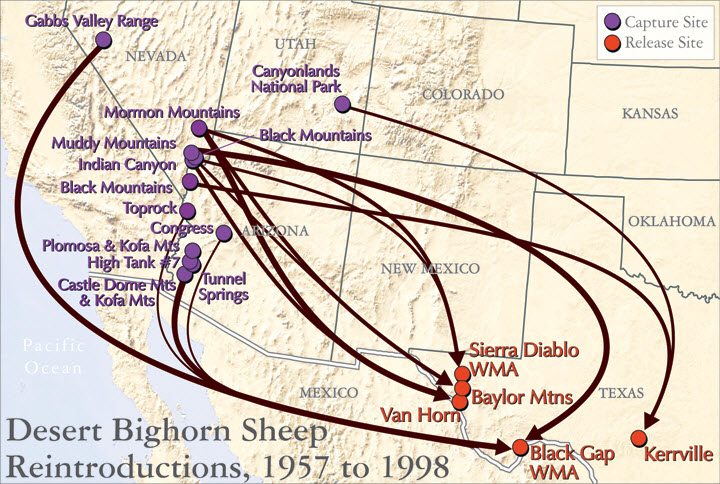Ancient west Texas pictographs indicate that people and desert bighorn sheep (Ovis canadensis nelsoni) have coexisted for millenia. In fact, the Trans Pecos is believed to have hosted 1500 to 2500 bighorns as late as 1880. However, development of the area for mining, railroad construction, and domestic sheep herding put enormous pressure on the bighorns, leading to their eradication in the state by the early 1960s.
Fortunately, private non-profits, state and federal agencies joined together to secure protected lands (including Sierra Diablo, Black Gap, Baylor Mountains, Elephant Mountain, Chilicote Ranch and Big Bend Ranch State Park), to enforce hunting regulations, and to undertake innovative transplants and captive breeding operations for the sheep’s restoration. The map on this page shows a number of the interstate reintroduction efforts that have helped bring the desert bighorn back to Texas.
Map sources:
Brewer, Clay. 2014. Chair, Western Alliance of Fish and Wildlife Agency Wild Sheep Working Group. Biologist, Texas Parks and Wildlife. Personal communications.
Harverson, Louis. 2014. Director, Borderlands Research Institute for Natural Resource Management, Sul Ross State University. Personal communications.
Wild Sheep Working Group. 2014. Desert Bighorn Sheep Reintroduction Worksheet, 1957-2011.
Selected references:
Davis, William and Walter Taylor. 1939. “The Bighorn Sheep of Texas”, Journal of Mammalogy, Vol. 20, No. 4, pp. 440-455.
Monson, Gale and Lowell Sumner, ed. 2003. The Desert Bighorn: Its Life History, Ecology, and Management. The University of Arizona Press.
Schmidly, David. 2002. Texas Natural History: A Century of Change. Texas Tech University Press. Lubbock, Texas.

